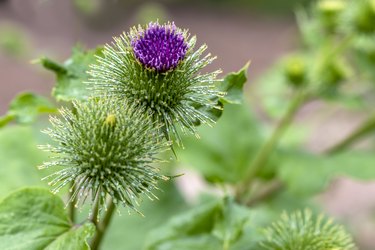
Burdock (Arctium minus, USDA plant hardiness zones 3a to 10a) belongs to the aster family and is an herbaceous, biennial wildflower. It's commonly found growing in pastures, fields, woodlands, ditches, empty lots, and other disturbed areas. It grows throughout much of North America, and due to its aggressive and invasive growth, it has made the U.S. Department of Agriculture's list of invasive, introduced, and noxious plants. Once a burdock infestation takes hold, it can be difficult to get rid of it, but with a little work and attention, it's possible.
Notable Characteristics of Burdock Weed
Video of the Day
Burdock goes by a variety of common names, including common burdock, lesser burdock, and beggar's button. A European native, burdock was accidentally introduced to the U.S. and can now be found growing throughout all of the lower 48 states except for Florida. Due to the plant's robust growth, it competes and takes over the habitats of native plants.
Video of the Day
Burdock grows into tall plants reaching up to 7 feet high and is made up of thick branches that are green to purplish-red. Heart-shaped foliage grows up to 2 feet long, forming from a basal rosette and with the underside covered in wooly hairs. During its first year of growth, only the rosette of foliage develops, but during its second year of growth, the burdock attains its height and blooms. In summer, purple or pink clusters of thistlelike flowers develop that have sharp hooks that form into prickly burrs.
The burrs assist in the plant's dispersal of seeds by attaching to animals or birds and can become windborne. Once attached, the burrs are very difficult to remove, and if exposed to the burrs, horses, livestock, dogs, and humans can suffer severe irritation and infection of the eyes and skin as well as the respiratory tract.
Taming a Burdock Infestation
When it comes to getting rid of burdock, it's easier to eliminate the problem while the plant is in its first year of growth and hasn't flowered or produced seed. One plant produces around 15,000 seeds that remain viable for a long time, so between its long taproot and the massive number of seeds, it can be difficult to eradicate the plant once it's allowed to thrive. If you desire a more organic method of eradication, you can dig up the plant using a sharp spade shovel, being sure to chop into the underground tap root. You can also use a burdock removal tool, like a dandelion remover, to dig out smaller burdock plants and then pull them out of the ground by hand.
Another option is to mow the burdock plants before the blooms have a chance to produce seeds. Continue to mow the plants as they begin to resprout. Or you can snip off the flower heads before they produce seeds, place them in a bag, and discard them in the trash. You will want to wear gloves so the burrs don't scratch your hands and skin.
You can also spray the plants with the herbicide glyphosate, being sure not to get the herbicide on desirable plants. If you have native grasses growing in the same location as the burdock, mixing 5 ounces of an herbicide product containing clopyralid will kill the burdock but not damage the grass. Always follow label directions for mixing and application and don't apply it on a windy day or if rain is in the forecast. Keep children and pets out of the area until the product dries. You should see the burdock starting to die in a couple of days to a week, but a second application may be required to finish the job.